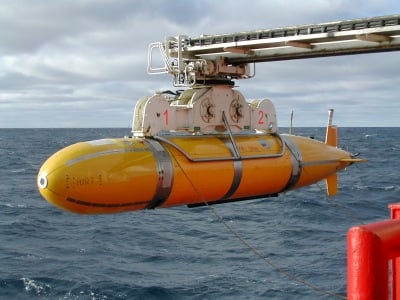This article is more than 1 year old
Antarctic glacier melt maybe 'not due to climate change'
Brit D-cell robot torpedo probes massive icy bottom
Opinion British and international boffins, having probed an Antarctic glacier which is thought to be a major cause of rising sea levels worldwide, report that increased polar ice melting may not be driven by climate change.

The latest in scientific bottom-probing battery powered devices.
The massive ice river in question is the Pine Island Glacier, aka PIG to those in the field.
“Estimates of Antarctica’s recent contributions to sea level rise have changed from near-zero to significant and increasing," says Stan Jacobs of Columbia uni in the States. "Increased melting of continental ice also appears to be the primary cause of persistent ocean freshening and other impacts."
The PIG has flowed more and more rapidly into the Amundsen Sea since scientists have begun monitoring it, adding fresh water to the world's oceans. Like certain other regions the glacier is bucking the overall south-polar trend which has actually seen hundreds of thousands of square kilometres of new sea ice accumulate around Antarctica in recent decades.
Many scientists have theorised that the PIG's accelerating flow is due to global warming. However, recent research - including surveys beneath the bottom of the floating, projecting ice sheet by Blighty's Autosub robot probe - indicate that this may not be the case. (The Autosub, famously, was powered by some 5,000 ordinary alkaline D-cell batteries on each trip beneath the ice, getting through some four tonnes of them during the research.)
It appears from the Autosub's under-ice surveys that the PIG's ice flow formerly ground its way out to sea across the top of a previously unknown rocky underwater ridge, which tended to hold it back. Many years ago, however, before the area was surveyed in much detail, the glacier's floating outflow sheet separated from the ridge top which it had been grinding away at for millennia and so picked up speed. This also allowed relatively warm sea water to get up under the sheet and so increase melting and ease of movement.
“The discovery of the ridge has raised new questions about whether the current loss of ice from Pine Island Glacier is caused by recent climate change or is a continuation of a longer-term process that began when the glacier disconnected from the ridge," says Dr Adrian Jenkins of the British Antarctic Survey.
Jenkins, Jacobs and their colleagues write:
Once the grounding line began its downslope migration from the ridge crest prior to the 1970’s, a period of rapid change was inevitable, and since that time oceanic variability may have had relatively little influence on the rate of retreat.
Or in other words the glacier would have shown the same acceleration and thinning it has shown since the 1990s with or without climate change, perhaps accounting for its very rapid melting and the local contrast with the general picture of increased Antarctic sea ice.
The scientists' research is published by Nature Geoscience, here (subscription link). ®
